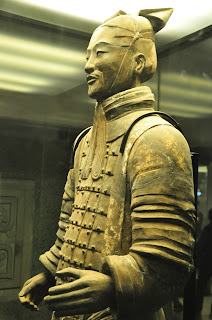After getting off our never-ending bus ride, we hailed a cab and were dropped off at our hostel, the great and well-located Shuyuan Youth Hostel (www.hostelxian.com).
The hostel was located just inside the south gate of Xi'an's impressive city wall, spanning over 14km in total length. We climbed the wall and walked along in search of some of Xi'an's former opulence.
Xi'an was the capital of the Qin, Han, Sui and Tang dynasties, when it was known as Cheng'an. It was also the base for administration and governance of the very lucrative silk route through central Asia towards the west, bringing Xi'an immeasurable wealth and power.
Wandering around the wall left little evidence of its former glory: grey polluted air as far as the eye could see, with modern, drab buildings occupying most of the livable space.
We descended the wall and walked east towards the impressive drum tower and central bell tower occupying a round-about reminiscent of a Chinese Arc-de-Triumphe.
As we were nearing the Muslim quarter, we randomly ran into Camilla and Fredrika, the two Swedish girls Josh had uninvited to Jiankou when we were staying at Sanlitun hostel in Beijing. They had already been in Xi'an for a few days and showed us around the Muslim quarter.
From there we took the metro and wandered around in search of Xi'an's famous Da Yan Ta or Great Goose Pagoda. The Great Goose Pagoda was built in 652 during the Tang dynasty to house scriptures of the monk Xuanzang's 15-year journey to India. This impressive, towering structure has remained Xi'an's most recognizable landmark for over a thousand years.
That evening we enjoyed some beers and planned our trip to the neighboring province of Henan to visit the otherworldly Longmen Grottos, a UNESCO world heritage site. As luck would have it, Winnie had just checked into our hostel and would be sleeping in our room. He also decided to join us to the grottos the following day.
To my surprise, everyone was up and ready to leave by 7:15 am. We took a metro to Xi'an's northern train station, where we took a bullet train to Luoyang.
Luoyang is almost 400km away from Xi'an, but the train only took an hour and 20 minutes to get there.
Crazy!
The five of us then hired a little van to take us to the entrance of the site. We spent the next few hours visiting the beyond impressive caves.
The Longmen Caves or Dragon Gate Grottos are one of China's surviving masterpieces of Buddhist rock carving. First started in 494 AD, it took over 200 years to sculpt the more than 100,000 images of Buddha and his disciples.
The caves are spread along the east and west sides of the Yi river and provide undeniable evidence to the level of devotion and artistic ability of the Northern Wei dynasty, who meticulously carved these fantastic caves.
Unfortunately, many of the caves have been vandalized or destroyed at various points in China's tumultuous history.
The most impressive and gigantic cave-temple is that of Ancestor Worshipping, whose central 17m seated-Buddha and equally massive Manjusri and Samantabhadra provided many awesome and hilarious photo-ops.
After such impressive caves on the west side, the barren eastern side only warranted a quick glance and visit to an accompanying temple.
The next day, Josh, Winnie, and I, along with a Dutch couple were headed to what Xi'an is most known for and yet another UNESCO world heritage site: the Terra cotta warriors.
We caught local transport pretty easily and made our way to the surprisingly large site. We decided to follow the guide book's suggestions and visit the 3 pits in increasingly impressive order, starting with a somewhat long-winded but still informative movie on Qin Shi Huang, the emperor responsible for the warriors.
From there we went to a museum explaining the grandeur of emperor Qin's funerary complex and showing some significant finds such as the beautiful bronze chariots and horses.
Our introduction to the warriors themselves was with pit 3, housing 68 senior officers in various states of repair and 4 horses staring towards an upward ramp.
We then went to pit 2, which is a much larger room than pit 3, but a majority of the soldiers and horses are still being excavated or remain in pieces. There are, however, several soldiers and horses wonderfully preserved and kept behind glass beside the pit.
We left pit 2 and entered the airplane-hangar-sized pit 1 and were in awe by the thousands of terra cotta warriors standing in rows and in battle formations, all facing east and looking ready for battle.
Thankfully, the pit was large enough that you didn't have to fight your way through constant crowds, although it was a bit of a shame you couldn't get closer to the warriors. Still incredible none-the-less!
That evening I met up with Kim, our couchsurfing host in Beijing, his girlfriend Xinying and his father visiting from Germany. We met at an amazing vegetarian restaurant and I recounted our now hilarious ordeal getting to and from Pingyao.
I had told Xinying that we planned on climbing Mount Huashan the next day even though Josh felt a bit sick (his reason for not joining us for dinner). She said it is difficult enough even when you're healthy. She said that we're crazy and I thought: yeah, sounds about right!




























No comments:
Post a Comment